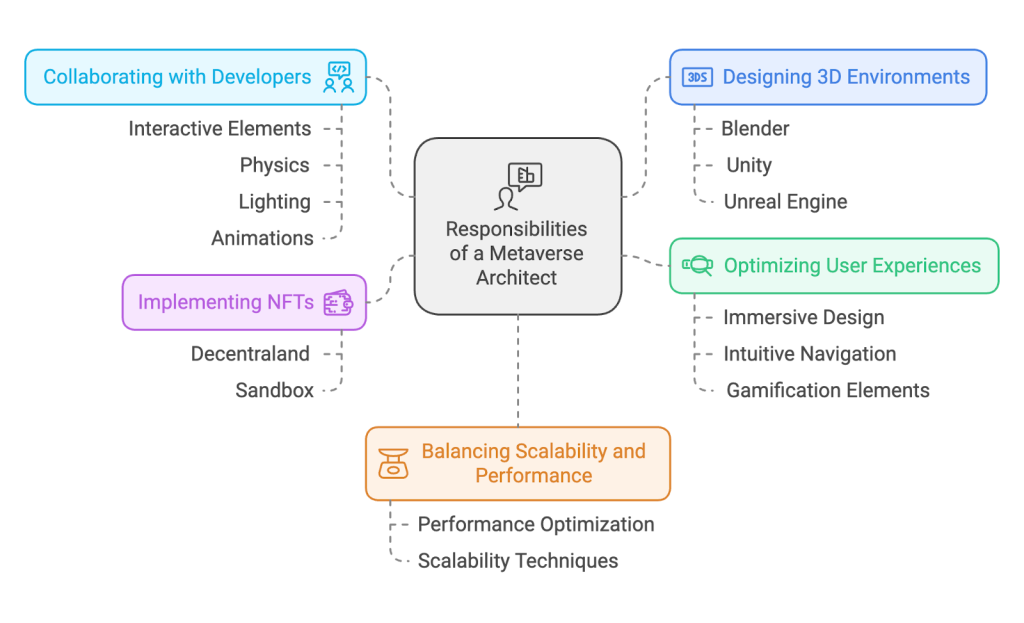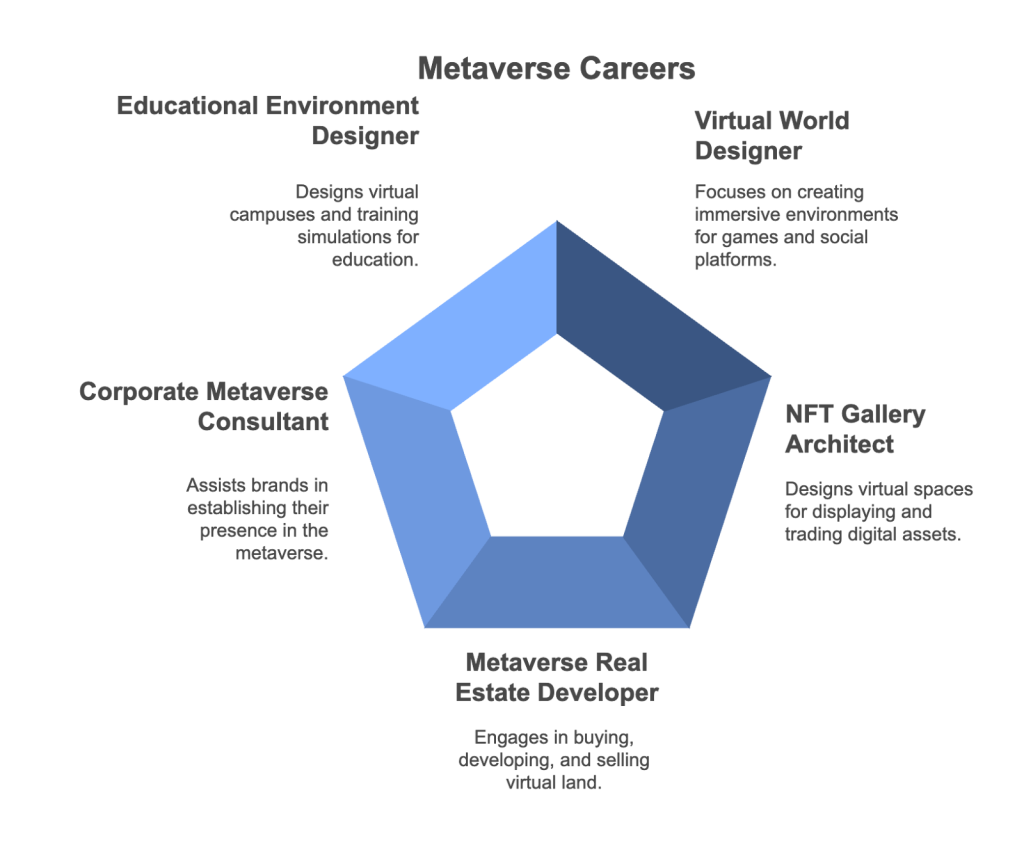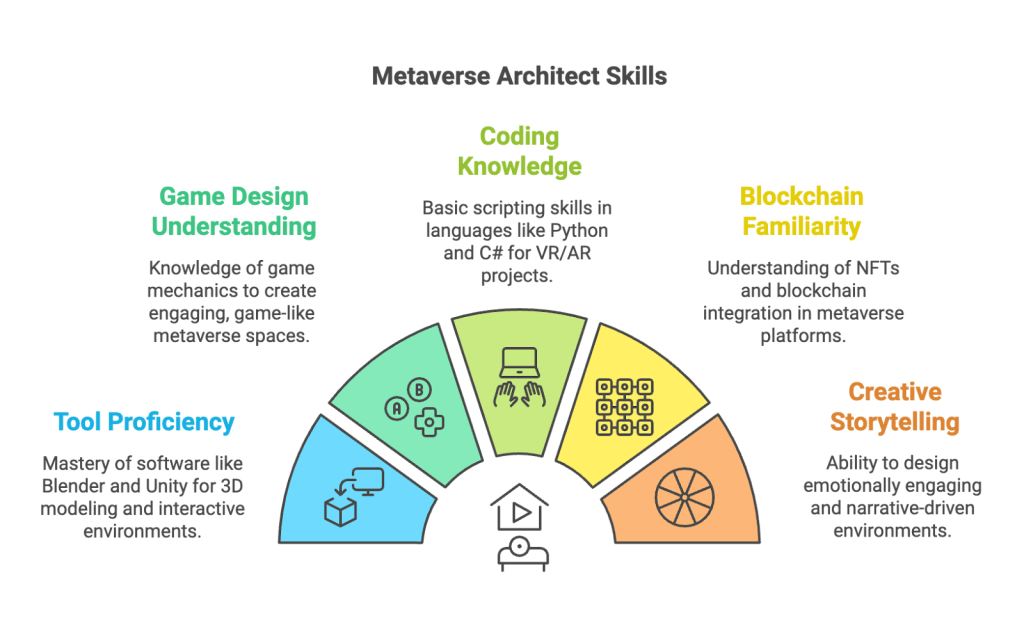How to Become a Metaverse Architect: Career Paths and Courses
The metaverse is no longer a distant concept from science fiction – it’s a rapidly evolving digital frontier blending virtual reality (VR), augmented reality (AR), blockchain, and social interaction. With companies like Meta, Roblox, Decentraland, and Epic Games investing billions into building these virtual worlds, a new breed of designers is emerging: Metaverse Architects.
Metaverse architects design immersive, interactive, and scalable digital environments for users to explore. Whether it’s creating virtual offices, NFT galleries, or entire gaming ecosystems, this career combines creativity, technical skills, and a passion for futuristic technologies. This guide will explore what it takes to become a metaverse architect, the career paths available, and the best courses to help you get started.
What Is a Metaverse Architect?
A metaverse architect is a professional who designs and builds spaces in the digital universe. These architects create virtual environments that users can interact with, ranging from game worlds and marketplaces to social hubs and educational spaces. Unlike traditional architecture, metaverse architecture focuses on user experience, interactivity, and accessibility across various devices like VR headsets, AR glasses, or even smartphones.
What Does a Metaverse Architect Do?
Metaverse architects combine design and technology to craft engaging digital spaces. Here are some key responsibilities:
- Designing 3D Environments: Architects create virtual buildings, landscapes, and interiors using software like Blender, Unity, or Unreal Engine.
- Optimizing User Experiences: Ensuring spaces are immersive and intuitive for users to explore, often integrating gamification elements.
- Collaborating with Developers: Working alongside programmers to implement interactive elements like physics, lighting, and animations.
- Implementing NFTs: Designing spaces that showcase or integrate non-fungible tokens, such as galleries or exclusive event areas in platforms like Decentraland or Sandbox.
- Balancing Scalability and Performance: Ensuring virtual environments run smoothly, even with many users accessing them simultaneously.

Career Paths for Metaverse Architects
Metaverse architecture isn’t limited to one field – it spans gaming, social media, real estate, fashion, and more. Here are some of the most popular career paths for metaverse architects:
1. Virtual World Designer
As a virtual world designer, you’ll focus on creating expansive, immersive environments for games or social platforms. This could involve designing entire cities in platforms like Roblox, Fortnite Creative, or Second Life.
2. NFT Gallery Architect
NFTs are a massive part of the metaverse economy. NFT gallery architects design stunning virtual spaces to display digital assets. Platforms like Cryptovoxels or Somnium Space often hire architects to craft visually compelling environments where NFTs can be showcased, traded, or even experienced interactively.

3. Metaverse Real Estate Developer
Yes, virtual real estate is a thing – and it’s big business. Metaverse real estate developers buy, develop, and sell land on platforms like Decentraland and Sandbox. Architects in this space design properties that buyers will find desirable, from luxury villas to entertainment hubs.
4. Corporate Metaverse Consultant
Companies like Nike, Adidas, and Gucci already established their presence in the metaverse. As a consultant, you might help brands design virtual stores, event spaces, or branded experiences tailored to their audiences.
5. Educational or Training Environment Designer
Architects must design virtual campuses, training simulations, and collaborative workspaces that use the metaverse for training and education. Consider medical students practicing surgery in VR or employees learning new skills in immersive, gamified environments.
Skills You Need to Succeed
1. Proficiency in 3D Modeling and Design Tools
You’ll need expertise in tools like:
- Blender: For creating 3D models.
- Autodesk Maya: For advanced animation and modeling.
- Unity and Unreal Engine: For building interactive environments and rendering.
These tools are the backbone of metaverse architecture, allowing you to craft and bring to life virtual spaces.
2. Understanding of Game Design Principles
Many metaverse environments incorporate game-like elements. Understanding game mechanics, player behavior, and interactivity will help you design more engaging spaces. Platforms like Unity Learn or Epic Games’ Unreal Academy offer great resources to get started.
3. Coding and Scripting Knowledge
While not every metaverse architect needs to be a coder, understanding basic scripting can be a huge asset. Languages like Python, C#, and JavaScript are often used in VR/AR projects or game engines.

4. Familiarity With Blockchain and NFTs
Many metaverse platforms are built on blockchain technology. Understanding how NFTs work and how to integrate them into your designs can set you apart. Explore platforms like OpenSea, Rarible, or Foundation to learn more.
5. Creative Storytelling and Design Thinking
Metaverse spaces aren’t just functional – they’re experiences. It’s critical to be able to tell a story through your designs or create emotionally engaging environments. Courses in design thinking, like those offered by IDEO U, can help sharpen your creative skills.
How to Get Started: Best Courses and Resources
There’s no single degree for metaverse architecture yet, but plenty of courses and resources can help you develop your needed skills. Here are some top picks:
1. 3D Modeling and Game Development Courses
- Unity Learn: Offers free and paid tutorials to master Unity, a leading platform for metaverse development.
- Blender Guru (YouTube): Free tutorials on mastering Blender for 3D modeling.
- Unreal Engine Online Learning: A free resource by Epic Games, teaching Unreal Engine for creating immersive environments.
2. Blockchain and NFT Courses
- Blockchain Basics (Coursera): A beginner-friendly introduction to blockchain technology.
- NFT Fundamentals (Udemy): Learn how to create, mint, and showcase NFTs in the metaverse.
- Decentraland University: Tutorials on designing and monetizing in Decentraland.
3. AR/VR Development Programs
- XR Development with Unity (Coursera): Learn to create AR and VR experiences.
- VR Starter Kit (Udemy): Build immersive VR applications using industry tools.
- MIT Media Lab’s AR/VR Online Resources: Advanced insights into XR development.
4. Creative and Storytelling Workshops
- Design Thinking by IDEO U: A course on creating human-centered designs.
- Storytelling for Designers (LinkedIn Learning): Learn how to craft compelling narratives in your designs.

Building Your Portfolio
Your portfolio is your gateway to landing jobs or freelance gigs as a metaverse architect. Here’s how to make it stand out:
Landing Your First Job
Where to Look
- Freelance Platforms: Websites like Fiverr or Upwork have a growing demand for metaverse designers.
- Dedicated Metaverse Platforms: Check Decentraland, Roblox, and Sandbox job boards.
- Corporate Job Boards: Companies like Meta, Epic Games, and Microsoft often list metaverse-related roles.
What Employers Look For
- A portfolio showcasing creativity and technical skill.
- Hands-on experience with VR/AR tools and platforms.
- Knowledge of blockchain and NFTs for metaverse integration.
Conclusion
Becoming a metaverse architect is an exciting, dynamic career path at the forefront of digital innovation. With the right mix of technical skills, creativity, and understanding of blockchain technologies, you can help shape the future of virtual worlds. Mastering 3D modeling tools, learning game development, and exploring blockchain concepts. The metaverse is growing fast – don’t wait to carve out your space in this cutting-edge field!




